Integral Bifurcation Method together with a Translation-Dilation Transformation for Solving an Integrable 2-Component Camassa-Holm Shallow Water System
Abstract
An integrable 2-component Camassa-Holm (2-CH) shallow water system is studied by using integral bifurcation method together with a translation-dilation transformation. Many traveling wave solutions of nonsingular type and singular type, such as solitary wave solutions, kink wave solutions, loop soliton solutions, compacton solutions, smooth periodic wave solutions, periodic kink wave solution, singular wave solution, and singular periodic wave solution are obtained. Further more, their dynamic behaviors are investigated. It is found that the waveforms of some traveling wave solutions vary with the changes of parameter, that is to say, the dynamic behavior of these waves partly depends on the relation of the amplitude of wave and the level of water.
1. Introduction
Although (1.1) can be reduced to (1.3) by the scaling transformation , the dynamic properties of some traveling wave solutions for these two equations are very different. In fact, the dynamic behaviors of some traveling waves of system (1.1) partly depends on the relation () of the amplitude of wave and the level (deepness) of water. In the other words, their dynamic behavior vary with the changes of parameter ε, that is, the changes of ratio for the amplitude of wave and the deepness of water ℏ. In addition, compared with the research results of (1.3), the research results for (1.1) are few in the existing literatures. Thus, (1.1) is very necessary to be further studied.
It is worthy to mention that the solutions obtained by us in this paper are different from others in existing references, such as [9, 12–17, 29]. On the other hand, under different transformations, by using different methods, different results will be presented. In this paper, by using the integral bifurcation method [31], we will investigate different kinds of new traveling wave solutions of (1.1) and their dynamic properties under the translation-dilation transformation u(x, t) = v[1 + ϕ(x − vt)], ρ(x, t) = v[1 + ψ(x − vt)]. By the way, the integral bifurcation method possessed some advantages of the bifurcation theory of the planar dynamic system [32] and auxiliary equation method (see [33, 34] and references cited therein), it is easily combined with computer method [35] and useful for many nonlinear partial diffential equations (PDEs) including some PDEs with high power terms, such as K(m, n) equation [36]. So, by using this method, we will obtain some new traveling wave solutions of (1.1). Some interesting phenomena will be presented.
The rest of this paper is organized as follows. In Section 2, we will derive the two-dimensional planar system of (1.1) and its first integral equations. In Section 3, by using the integral bifurcation method, we will obtain some new traveling wave solutions of nonsingular type and singular type and investigate their dynamic behaviors.
2. The Two-Dimensional Planar System of (1.1) and Its First Integral Equations
3. Traveling Wave Solutions of Nonsingular Type and Singular Type for (1.1) and Their Dynamic Behaviors
In this section, we will investigate different kinds of exact traveling wave solutions for (1.1) and their dynamic behaviors.
It is easy to know that (2.9) can be reduced to four kinds of simple equations when the parametric conditions satisfy the following four cases:
Case 1. A = ε − 2, h = 12σ(ε − 2)/ε2δ2 and ε ≠ 0,2, v ≠ εκ/4(1 − ε).
Case 2. v = εκ/4(1 − ε), h = 12σ(ε − 2)/ε2δ2 and ε ≠ 0,1, A ≠ ε − 2.
Case 3. A = ε − 2, h = 12σ(ε − 2)/ε2δ2, v = εκ/4(1 − ε) and ε ≠ 0,1, 2.
Case 4. h = 12σ(2A+2−ε)2/ε2δ2(ε − 2).
We mainly aim to consider the new results of (1.1), so we only discuss the first two typical cases in this section. The other two cases can be similarly discussed, here we omit them.
3.1. The Exact Traveling Wave Solutions under Case 1
- (i)
If a > 0, then (3.2) has one exact solution as follows:
()Substituting (3.4) into (2.7), and then integrating it yields()Substituting (3.4) into (2.2) and (2.4), then combining with (3.5), we obtain a couple of soliton-like solutions of (1.1) as follows:()() - (ii)
If a > 0, c > 0, Δ > 0, then (3.2) has one exact solution as follows:
()Similarly, by using (3.8), (2.7), (2.2), and (2.4), we obtain two couples of soliton-like solutions of (1.1) as follows:() - (iii)
If a > 0 and Δ < 0, then (1.1) has one couple of soliton-like solutions as follows:
() - (iv)
If a > 0 and c ≠ 0 (i.e., ε ≠ 0), then (1.1) has one couple of soliton-like solutions as follows:
() - (v)
If a > 0 and Δ = 0 (i.e. ), then (1.1) has one couple of kink and antikink wave solutions as follows:
() - (vi)
If a > 0 and b = 0 (i.e. κ = 4v(1/ε − 1)), then (1.1) has one couple of soliton-like solutions as follows:
()
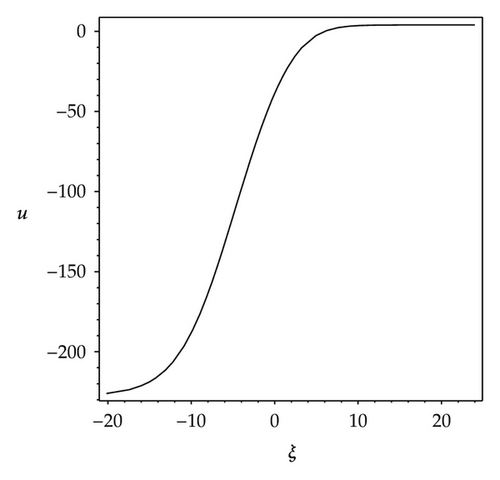
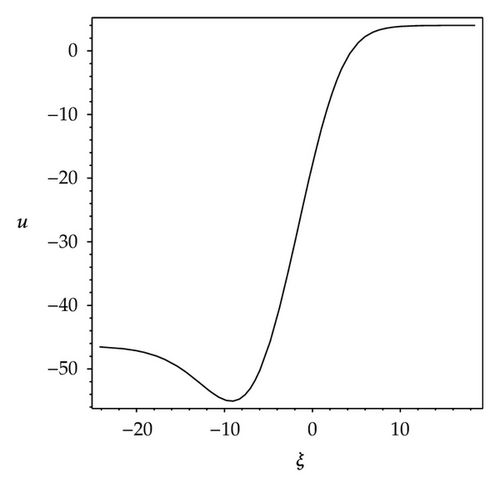
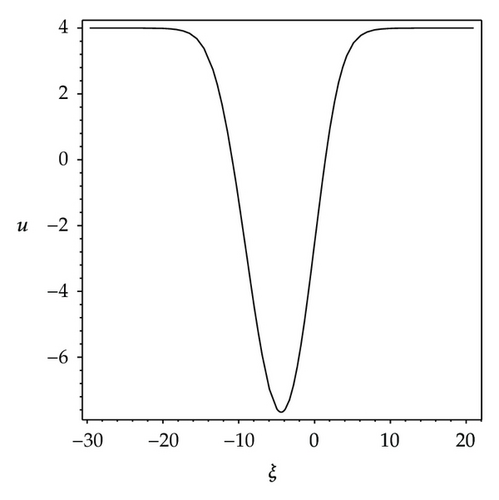
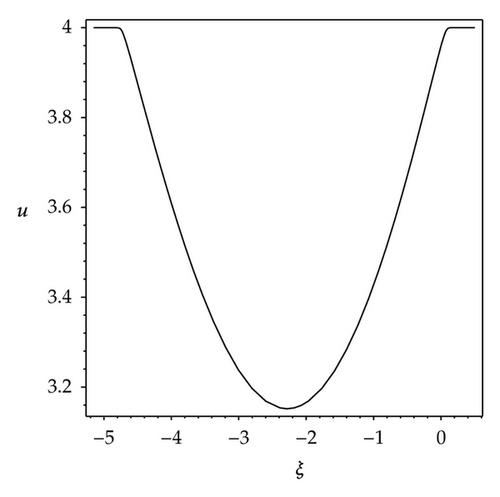
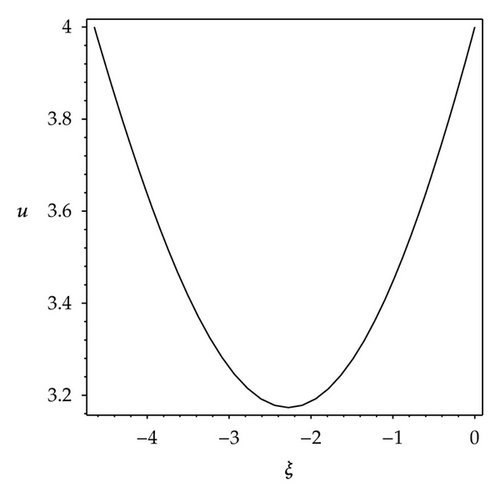
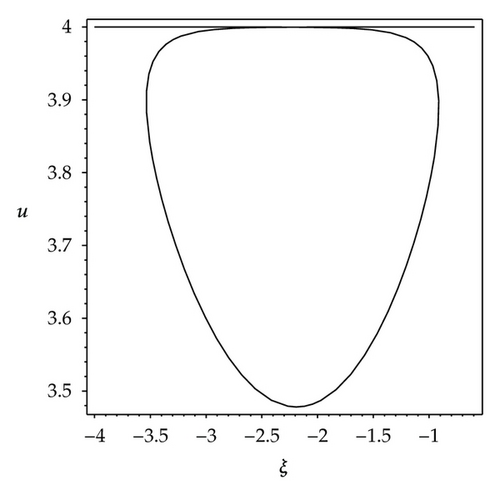
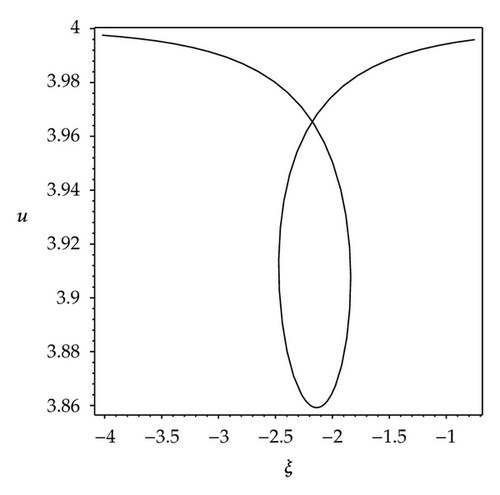
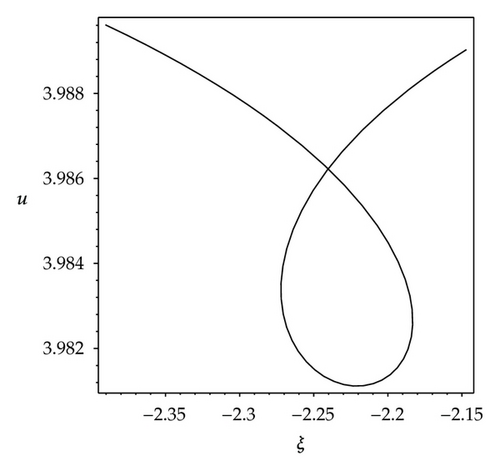
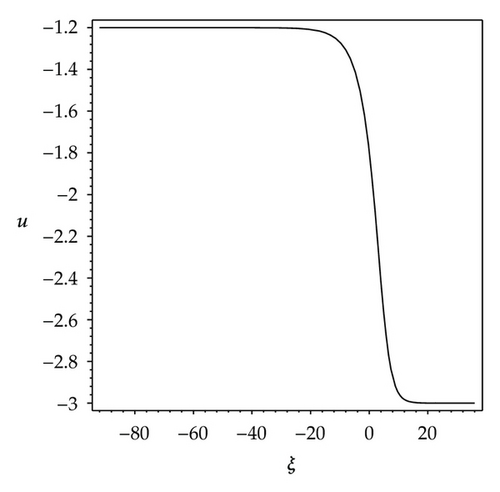
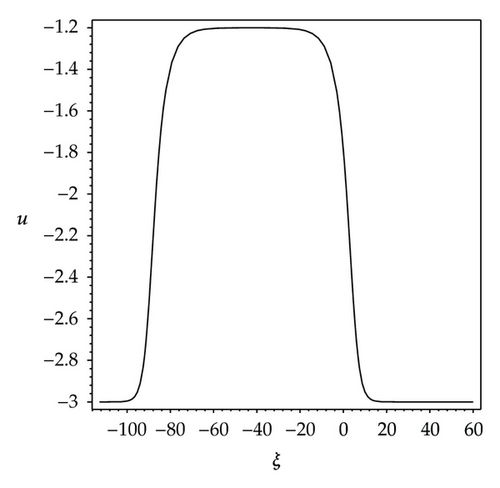
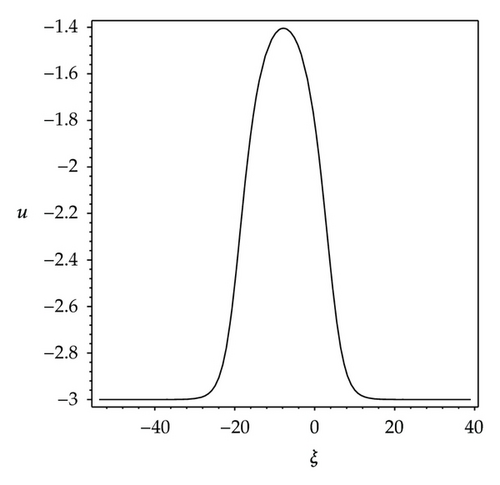

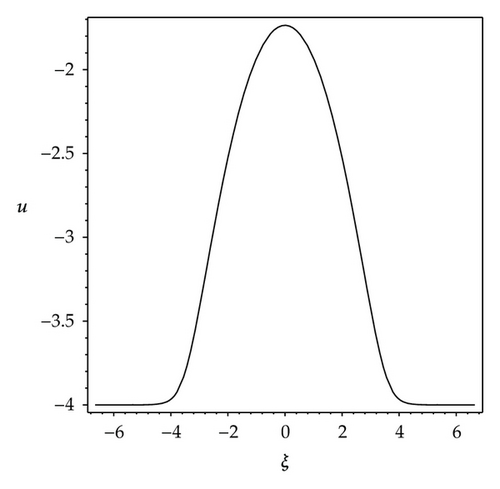
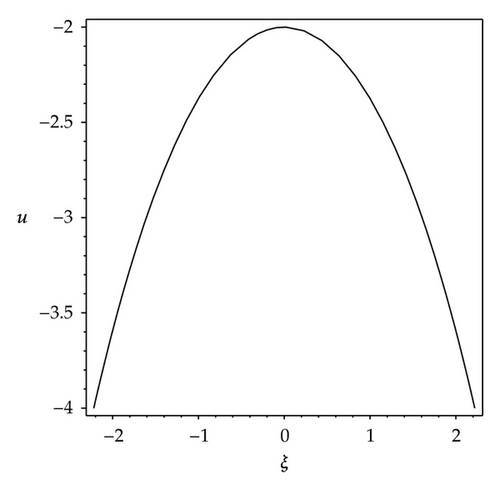
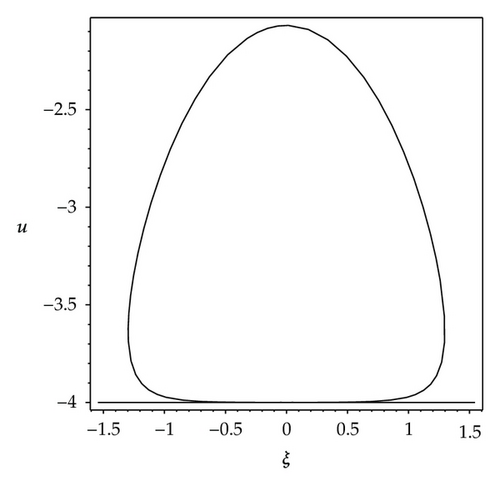
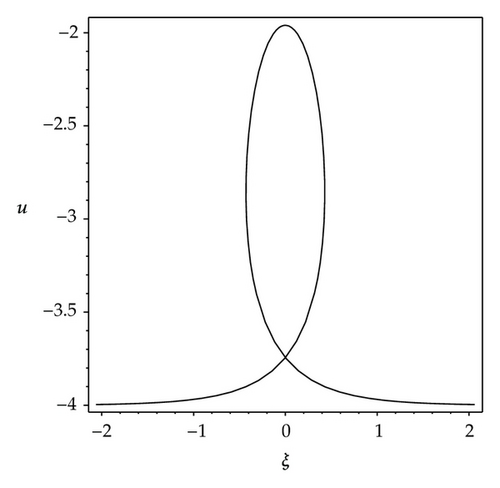
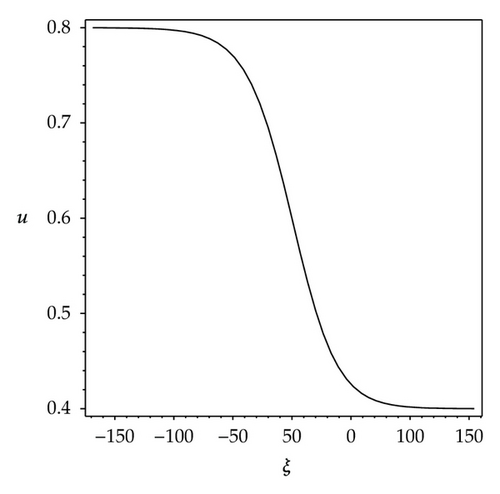
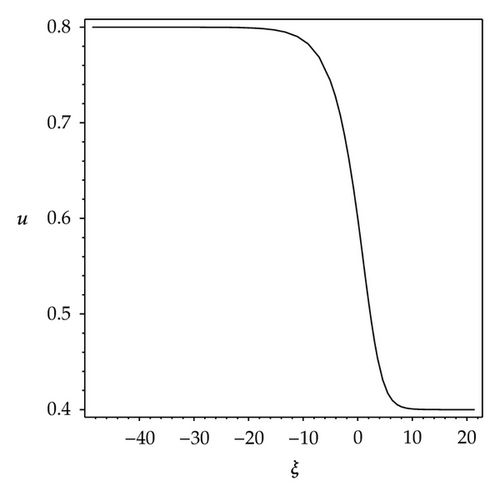
We observe that some profiles of above soliton-like solutions are very much sensitive to one of parameters, that is, their profiles are transformable (see Figures 1–3). But the others are not, their waveforms do not vary no matter how the parameters vary (see Figure 4). Some phenomena are very similar to those in [41, 42]. In [41], the waveforms of soliton-like solution of the generalized KdV equation vary with the changes of parameter and depend on the velocity c extremely. Similarly, in [42], the properties of some traveling wave solutions of the generalized KdV-Burges equation depend on the dissipation coefficient α; if dissipation coefficient α ≥ λ1, it appears as a monotonically kink profile solitary wave; if 0 < α ≤ λ1, it appears as a damped oscillatory wave.
From Figures 1(a)–1(h), it is easy to know that the profiles of solution (3.6) vary gradually, its properties depend on the parameter ε. When parametric values of ε increase from 1.2 to 5, the solution (3.6) has eight kinds of waveforms: Figure 1(a) shows a shape of antikink wave when ε = 1.2; Figure 1(b) shows a shape of transmutative antikink wave when ε = 1.6; Figure 1(c) shows a shape of thin and dark solitary wave when ε = 1.4; Figure 1(d) shows a shape of fat and dark solitary wave when ε = 1.99; Figure 1(e) shows a shape of compacton wave when ε = 2; Figure 1(f) shows a shape of fat loop soliton when ε = 2.2; the Figure 1(g) shows a shape of thin loop soliton when ε = 3; Figure 1(h) shows a shape of oblique loop soliton when ε = 5.
Similarly, from Figures 2(a)–2(d), it is also easy to know that the profiles of solution (3.7) are transformable, but their changes are not gradual, it depends on the parameter ε extremely. When parametric values of ε increase from 1.2 to 2.4, the solution (3.7) has four kinds of waveforms: Figure 2(a) shows a shape of smooth kink wave when ε = 1.2; Figure 2(b) shows a shape of fat and bright solitary wave when ε = 1.20000001; Figure 2(c) shows a shape of thin and bright solitary wave when ε = 1.22; Figure 2(d) shows a shape of singular wave of cracked loop soliton when ε = 2.4. Especially, the changes of waveforms from Figure 2(a) to Figure 2(b) and from Figure 2(c) to Figure 2(d) happened abruptly.
As in Figure 1, the profiles of the first solution of (3.9) in Figure 3 vary gradually. When parametric values of ε increase from 1.8 to 2.8, the waveform becomes a bright compacton from a shape of bright solitary wave, then becomes a shape of fat loop soliton and a shape of thin loop soliton at last.
Different from the properties of solutions (3.6), (3.7) and (3.9), the property of the first solution of (3.12) is stable. The profile of the first solution of (3.12) is not transformable no matter how the parameters vary. Both Figures 4(a) and 4(b) show a shape of smooth kink wave.
3.2. The Traveling Wave Solutions Under Case 2
In order to show the dynamic properties of above periodic solutions intuitively, as examples, we plot their graphs of the solutions (3.20), (3.23) and (3.24), see Figures 5 and 6.

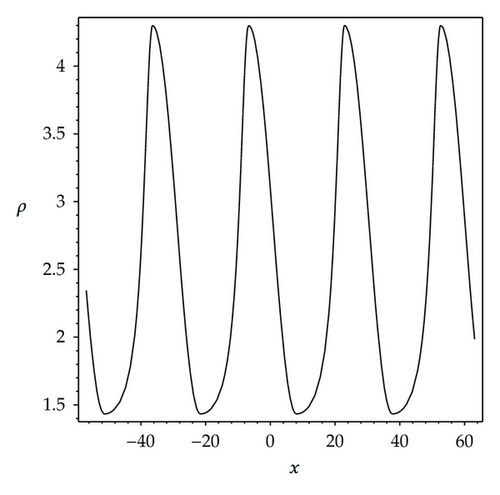
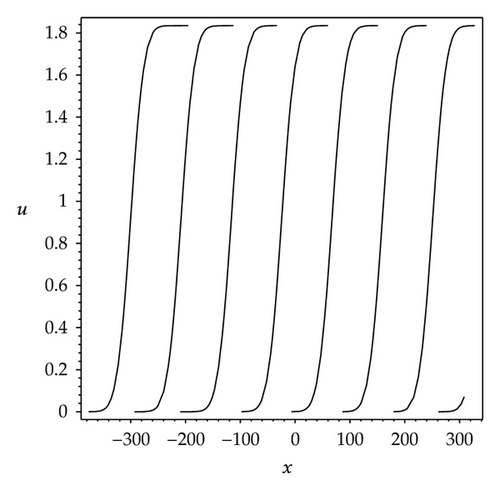
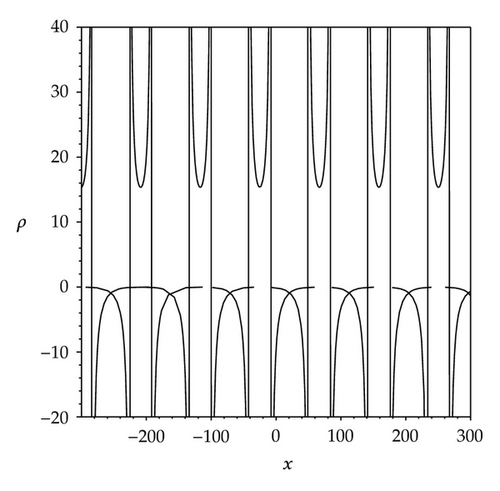
Figures 5(a) and 5(b) show two shapes of smooth and continuous periodic waves, all of them are nonsingular type. Figure 6(a) shows a shape of periodic kink wave. Figure 6(b) shows a shape of singular periodic wave. Both Figures 6(a) and 6(b) show two discontinuous periodic waves, all of them are singular type.
From the above illustrations, we find that the waveforms of some solutions partly depend on wave parameters. Indeed, in 2006, Vakhnenko and Parkes’s work [43] successfully explained similar phenomena. In [43], the graphical interpretation of the solution for gDPE is presented. In this analysis, the 3D-spiral (whether one loop from a spiral or a half loop of a spiral) has the different projections that is the essence of the possible solutions. Of caurse, this approach also can be employed to the 2-component Camassa-Holm shallow water system (1.1). By using the Vakhnenko and Parkes’s theory, the phenomena which appeared in this work are easily understood, so we omit this analysis at here. However, it is necessary to say something about the cracked loop soliton (Figure 2(d)) and the singular periodic wave (Figure 6(b)), what are the 3D-curves with projections associated with two peculiar solutions (3.7) and (3.24) which are shown in Figure 2(d) and Figure 6(b)? In order to answer this question, by using the Vakhnenko and Parkes’s approach, as an example we give the 3D-curves of solution (3.24) and their projection curve in the xoρ-plane, which are shown in Figure 7. For convenience to distinguish them, we colour the 3D-curves red and colour their projection curve green. From Figure 7, we can see that the 3D-curves are not intersected, but their projection curve is intersected in xoρ-plane.
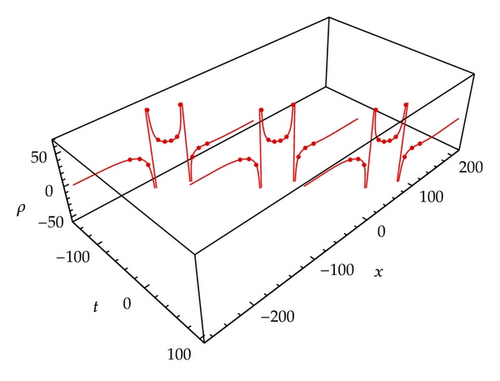
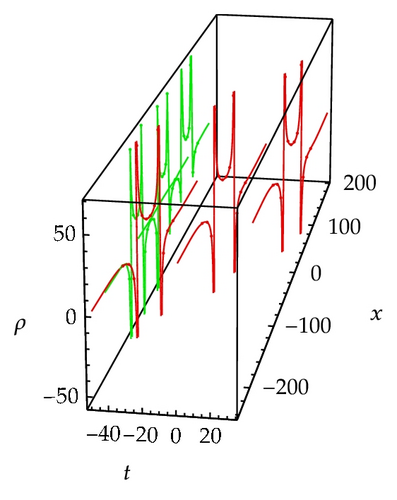
4. Conclusion
In this work, by using the integral bifurcation method together with a translation-dilation transformation, we have obtained some new traveling wave solutions of nonsingular type and singular type of 2-component Camassa-Holm equation. These new solutions include soliton solutions, kink wave solutions, loop soliton solutions, compacton solutions, smooth periodic wave solutions, periodic kink wave solution, singular wave solution, and singular periodic wave solution. By investigating these new exact solutions of parametric type, we found some new traveling wave phenomena, that is, the waveforms of some solutions partly depend on wave parameters. For example, the waveforms of solutions (3.6), (3.7), and (3.9) vary with the changes of parameter. These are three peculiar solutions. The solution (3.6) has five kinds of waveforms, which contain antikink wave, transmutative antikink wave, dark soliton, compacton, and loop soliton according as the parameter ε varies. The solution (3.7) has three kinds of waveforms, which contain kink wave, bright soliton, and singular wave (cracked loop soliton) according as the parameter ε varies. The solution (3.9) also has three kinds of waveforms, which contain bright soliton, compacton, and loop soliton according as the parameter ε varies. These phenomena show that the dynamic behavior of these waves partly depends on the relation of the amplitude of wave and the level of water.
Acknowledgments
The authors thank reviewers very much for their useful comments and helpful suggestions. This work was financially supported by the Natural Science Foundation of China (Grant no. 11161020) and was also supported by the Natural Science Foundation of Yunnan Province (no. 2011FZ193).




